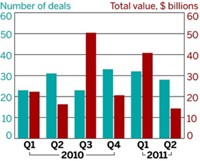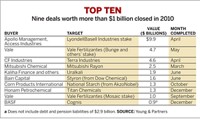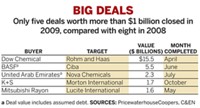Advertisement
Grab your lab coat. Let's get started
Welcome!
Welcome!
Create an account below to get 6 C&EN articles per month, receive newsletters and more - all free.
It seems this is your first time logging in online. Please enter the following information to continue.
As an ACS member you automatically get access to this site. All we need is few more details to create your reading experience.
Not you? Sign in with a different account.
Not you? Sign in with a different account.
ERROR 1
ERROR 1
ERROR 2
ERROR 2
ERROR 2
ERROR 2
ERROR 2
Password and Confirm password must match.
If you have an ACS member number, please enter it here so we can link this account to your membership. (optional)
ERROR 2
ACS values your privacy. By submitting your information, you are gaining access to C&EN and subscribing to our weekly newsletter. We use the information you provide to make your reading experience better, and we will never sell your data to third party members.
Business
Shuffling The Deck
2005 was a strong year for acquisitions, led by activity in commodity chemical deals
by Marc S. Reisch
February 20, 2006
| A version of this story appeared in
Volume 84, Issue 8

The big deals were bigger and the financial buyers were still important players in the chemical mergers and acquisitions (M&A) game in 2005. It was a strong year overall for chemical deals, particularly in the commodity chemical sector, because the business was on the upswing and money was available to finance the activity.
The value of all chemical deals consummated worldwide in 2005 reached $33 billion, up from $31 billion in 2004, according to Peter Young, president of Young & Partners, an investment banking firm that provides merger, acquisition, divestiture, and other services to chemical and life sciences firms. As large as those numbers are, they are still off from the peak years of 1998 and 1999 when the value of such deals reached $38 billion and $39 billion, respectively.
Young, who shared with C&EN his recently completed study on chemical industry financial trends, says 73 deals valued at more than $25 million apiece were completed last year. However, the number of deals completed was off from the 2004 peak of 85.
The biggest transaction of the year was Ineos Group's $9.0 billion purchase of olefins and derivatives maker Innovene from BP. In 2004, the biggest deal was Koch Industries' purchase of DuPont's Invista textile operations for $4.2 billion.
Private investment funds, often called financial buyers, were responsible for four of the 10 largest chemical acquisitions in 2005, while strategic corporate buyers accounted for the rest. Overall, financial buyers were responsible for 27% of the 73 deals completed in 2005, up from 25% of deals in 2004.
Valuewise, financial buyers of chemical assets spent $11.6 billion in 2005, versus $10.9 billion in 2004. But because the value of all deals in 2005 was higher than in 2004, financial buyers' share of chemical deals value remained steady at about 35% in both years. The high point for financial buyers was in 2003, when they were responsible for 49% of the $21 billion in chemical M&A value.
Financial buyers are more of a force in chemical deals than they are in M&A overall. According to Dealogic, a business information provider to the investment banking community, private equity firms accounted for just 17%, or $499 billion, of the almost $3 trillion in 2005 global acquisition activity.
Dealogic does not break out M&A activity in the chemicals sector because it lagged behind the top M&A markets. In the industry that attracted the greatest activity, telecommunications, private equity accounted for just 19% of the $413 billion in deals completed last year.
Young's statistics show that the largest chemical acquisition by a financial buyer in 2005 was Access Industries' August takeover of polyolefins maker Basell from joint-venture partners BASF and Shell Chemical for $5.3 billion. Another financial buyer, PAI Partners, bought Chr. Hansen Food Ingredients business for $1.3 billion in July, while Texas Pacific Group bought polymer products maker British Vita for $1.3 billion in June. International Petroleum Investment Co. of Abu Dhabi along with its Austrian partner, oil refiner OMV, bought Borealis for $1.1 billion in October.
"Financial buyers are still strong, but they are not any stronger than they have been over the last few years, and they certainly are not dominant," Young points out. Before the mid-1990s, few financial buyers had the temerity to venture into chemicals, Young says. Environmental concerns and the strange names associated with the industry's products put many off, he adds.
But financial buyers learned from the example of Gordon Cain and D. George Harris, who made billions of dollars in the late 1980s and early 1990s when they assembled and later sold large chemical businesses stitched together from operations shed by DuPont, ICI, PPG Industries, and others. And the ease with which buyers can obtain loans today has also helped along many chemical deals, Young notes.
Because they have taken such an interest in chemical firms, financial buyers make possible deals that otherwise wouldn't get done, Young says. Underscoring this point, the National Venture Capital Association (NVCA) and Thomson Venture Economics (TVE) say more money than ever before is chasing after buyout opportunities.
NVCA, which represents U.S. firms that invest in start-up and existing businesses, and business information firm TVE compile annual statistics on venture capital and corporate buyout investments. The two say that funds raised to purchase existing businesses reached $86.2 billion last year, up 67% from 2004 and the highest yearly total ever recorded. By contrast, only $25.2 billion was raised to invest in start-up and early-stage businesses last year.
Although financial buyers were important last year, strategic buyers of chemical assets, led by Ineos, still dominated the M&A scene. Another large strategic buyer was Cytec Industries, which arranged the third largest acquisition in March of last year when it bought UCB's Surface Specialties business for $1.8 billion. In July, Crompton combined with Great Lakes Chemical to form Chemtura in a $1.7 billion deal-the fourth largest.
Other significant strategic acquisitions included Thai Olefin's purchase of National Petrochemical in December for $1.0 billion and BP's purchase of partner Solvay's interest in the BP Solvay Polyethylene venture for $1 billion in January. In October, German chemicals maker Altana acquired pigments maker Eckart for $760 million.
An upswing in the chemical business in 2005 allowed a number of private equity firms to take cash out of businesses they bought earlier, Young says. Seven firms staged initial public offerings in 2005, allowing outside investors to buy a piece of firms such as Celanese and Huntsman Corp. Six firms went public in 2004, compared with only one each in 2002 and 2003. The value of chemical IPOs reached more than $4 billion in 2005, up from $1.1 billion in 2004.
What's in the cards for 2006? "Expect another strong year for mergers and acquisitions," Young says. "Overall, it is a healthy environment with a lot of liquidity and factors that favor neither buyers nor sellers." And expect to see financial buyers maintain their interest, particularly firms like Blackstone Group, Apollo Management, and Kohlberg Kravis Roberts, all of which, Young says, are comfortable in the chemicals arena.
OVERVIEW
Industry's Big Picture Is Refocusing
David Ingles, a Ph.D. chemist who for more than 20 years was one of the top-rated chemical industry analysts in London and is now a consultant, says four key developments have changed the chemical industry over the past decade. He outlines them in "The Changing Structure of the Global Chemical Industry," a report published last month by London-based Cogency Chemical Consultants.
Broadly based companies are breaking up. "In fact, that model has been given up by most companies in the West now," Ingles says. "One of the few exceptions is BASF," although BASF did shed its pharmaceutical operations. The second development is a corollary to the first: Ingles notes that companies are focusing more on core businesses. Noncore businesses that are not paying their way are being shed.
Private equity investors are on the rise, and Ingles wonders what the medium- to long-term prospects are for this group of companies. "The private equity boys aren't in there for the long term," he observes, predicting major ownership changes in the next five years.
Finally, new producers and regions are emerging. Examples that he cites are Saudi Basic Industries Corp.'s purchase of DSM's petrochemicals operations in 2002 and the purchase of Borealis by Abu Dhabi interests in 2005.
There have been one or two Chinese chemical deals, he says. A case in point was the purchase of Australian polymers company Qenos by China National Chemical Corp. in October 2005. "And Reliance, of India, has been sniffing around. For example, they had been interested in Innovene," Ingles says. Indian producers have also been actively buying pharmaceutical intermediates producers as well. "These may not be big deals yet, but they are straws in the wind," he says.—Patricia Short






Join the conversation
Contact the reporter
Submit a Letter to the Editor for publication
Engage with us on Twitter